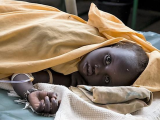Nov 2, 2010
PAHO: Haiti's cholera fatality rate dropping but still high
The case-fatality rate for cholera patients in Haiti has dropped some but is still higher than expected, mainly because of poor access to medical care, the Pan American Health Organization (PAHO) said today. At a news briefing, PAHO Deputy Director Jon Andrus said the fatality rate has ranged from 2% to 6.8%, compared with 9% reported previously. The latest PAHO numbers on the epidemic, reported yesterday, are 4,764 cases and 337 deaths. "We have information that approximately half the deaths occur without [patients] ever reaching the hospital," Andrus said. He also reported that 88% of case-patients in the most affected province, Artibonite, have been 5 years old or older. Besides Artibonite, cases have occurred in Central and West provinces, and suspected cases are being investigated in other provinces, including North, Northwest, and Northeast, he reported. Andrus also said health workers are trying to prepare for a possible strike by tropical storm Tomas. At the request of the Haitian government, PAHO teams are visiting hospitals and cholera treatment centers to check their readiness for the storm and to provide extra materials and medical supplies.
Andrus's statement at Nov 2 briefing
Nov 1 PAHO situation update
Meat producers anticipate testing for more E coli strains
Meat producers should prepare for future federal monitoring of non-O157:H7 strains of Shiga-toxin producing Escherichia coli (STEC), Jim Marsden, a science advisor for the North American Meat Producers Association, said at a recent conference, according to a report yesterday by Meatingplace.com. Dan Engeljohn of the US Department of Agriculture (USDA) Food Safety and Inspection Service (FSIS), said in another presentation at the conference that the FSIS has validated tests for four of six non-O157 STECs and is close to having a testing methodology for all six. The non-O157 STECS are thought to represent an emerging threat to the food supply, and over the past 3 years the USDA has considered adding them to its list of adulterants in meat, which would trigger testing. However, it has lacked the tests to rapidly detect the strains. The US Centers for Disease Control and Prevention (CDC) lists six non-O157 STEC strains that are pathogenic for humans: O26, O111, O103, O121, O45, and O145.
May 27 CIDRAP News scan
Researchers suggest plague originated in China 2,000 years ago
Genome sequencing has indicated that the organism responsible for the 14th-century outbreak of plague known as the Black Death, which killed 100 million people, originated in or near China more than 2,000 years ago, according to a letter in Nature Genetics. Researchers conducted phylogenetic analyses on 17 whole genomes of Yersinia pestis, the bacterium that causes plague, to trace their lineages. They reported, "Our phylogenetic analysis suggests that Y pestis evolved in or near China and spread through multiple radiations to Europe, South America, Africa, and Southeast Asia." The Black Death is thought have wiped out 30% to 60% of Europe's population, which took 150 years to rebound, according to a story on the report in Medical News Today.
Oct 31 Nature Genetics report
Nov 1 Medical News Today story
Study finds links between seasonal and pandemic flu vaccine coverage
Researchers from the Georgia Institute of Technology and the CDC found that states with high rates of flu vaccination during the H1N1 pandemic generally had higher rates of past seasonal flu immunizations and use of other preventive health services, according to a Georgia Tech press release today. The researchers examined factors that might have contributed to the wide range of pandemic vaccination rates, which varied from 34% in South Dakota to 9% in Mississippi. The findings were presented Oct 26 at the annual meeting of the Society for Medical Decision Making. Lower adult H1N1 vaccination coverage was seen in states where the disease circulated for a long time. Julie Swann, one of the authors and an associate professor in Georgia Tech's H. Milton Stewart School of Industrial and Systems Engineering, said this might have occurred because in households where someone had the flu, others did not feel the need to get vaccinated, according to the release. Vaccination uptake also was lower in states where it took more time to order allocated doses, the researchers found. The researchers also found that states with larger percentages of children had lower vaccine coverage, while an emphasis on vaccination at schools was associated with higher coverage.
Nov 2 Georgia Tech news release
HIV-positive and healthy kids respond similarly to H1N1 infection
A study of a series of 15 HIV-positive children ranging from 8 to 16 years old who were infected with pandemic 2009 H1N1 found that their clinical course, viral shedding, and antibody responses were comparable to those of children without HIV. All but one patient had symptoms within 7 days of infection, most commonly fever, cough, and fatigue. Eight children had only low-grade fevers for less than 24 hours and cough. Five patients who had high-grade fever, cough, and fatigue received oseltamivir (starting within 2 days of symptom onset) for 7 days instead of the usual 5 days over concern for possible severe disease in this immunocompromised population. Oseltamivir shortened the duration of viral shedding, and all patients tested developed novel H1N1–specific antibodies. The authors conclude, "In accordance with current recommendations, HIV-1–infected patients should be vaccinated, and in cases of suspected influenza infection, an empirical early antiviral treatment is strongly advised."
Oct 29 Clin Infect Dis abstract

















